Answers and Explanations
- B
- D
- E
- E
- A
- C
- B
- B
- B
- A
- D
- D
- A
- A
- D
- B
- D
- C
- C
- C
- B
- (B)
Step 1: Analyze the Question Stem
This is a Value question. You're given a figure and told that lines x and y are parallel, which makes the other lines in the figure transversals. When a transversal intersects a pair of parallel lines, all acute angles formed by that transversal will be equal, and all obtuse angles formed will be equal. Therefore, since angle a and angle b are both obtuse angles on the same transversal, they're equal to each other. Likewise, because angle c and angle d are obtuse angles formed by the same transversal, they're equal to each other. Since you're looking for the value of a + c, you'll have sufficiency if you have enough information to find one angle on each transversal or some sum of angles between the two transversals.
Step 2: Evaluate the Statements Using 12TEN
Statement (1) indicates that b − d = 20. Since you've already determined that b = a and d = c, you can rewrite this as a − c = 20. However, without having a value for either a or c, there's no way to determine the value of a + c, so this statement is insufficient. Eliminate (A) and (D).
Statement (2) says that b + d = 260. Since you know that b = a and d = c, you can rewrite this equation as a + c = 260. Thus, you have sufficiency. The correct choice is (B).
- (D)
Step 1: Analyze the Question
There are many relationships that you could deduce from the diagram. There are two ways to relate y to x. Looking at angles that make straight lines, you can say the following:

Or, looking at vertical angles, you can say this:
4y = x + 20
Those two equations alone would be enough to set up a two-variable, two-equation system to solve for both x and y. But this problem gives you even more:

Step 2: State the Task
The task is very straightforward: to solve for x. Given the deductions you made from the figure, you have your choice of equations in which to substitute 30 for y.
Step 3: Approach Strategically
If you use the first equation, you get this:

The correct answer is (D).
Or you could use the second equation:

(D) is correct.
Alternatively, you could have backsolved. If you aren’t comfortable with algebra, you might prefer this solution. Let’s say that you started with (B). If x = 60, then the angle on the bottom of the figure is 80°.
The angle on the left (2y) must make a straight line with that angle, so it must be 100°. If 2y = 100, then 4y = 200, so 2y + 4y = 300. But since 2y and 4y combine to make a straight line, they need to add up to 180, so y in this scenario is too big. To make y smaller, you must make x bigger. You can eliminate (A) and (B).
Testing (D), the angle at the bottom of the figure is 120°, so the angle on the left must be 60°. So 2y = 60, which makes 4y = 120 and 2y + 4y = 180. This is what you need, so the correct answer is (D).
Step 4: Confirm Your Answer
Reread the question stem, making sure that you didn’t miss anything about the problem.
- (E)
Step 1: Analyze the Question Stem
In the figure, you can observe that lines k, l, m, and n intersect at a central point and create eight angles. Note that you cannot assume that these angles are all equal, since you are not given any information explicitly stating this. Angle x is one of the 8 angles at this intersection. To solve for x, you need the values of at least three other angles that comprise a straight line with angle x or the value of the vertical angle across from x.
Step 2: Evaluate the Statements Using 12TEN
Statement (1) tells you that lines k and m are perpendicular to each other. This means that x is part of a 90-degree angle formed at the intersection of lines k and m. However, while you have narrowed down the range of values of x to less than 90 degrees, you cannot determine the specific value of x because you don’t know the orientation of line n relative either to line k or to line m. It does look as though it divides the angle perfectly in half, but you cannot determine exact angle measures simply from eyeballing the figure. Statement (1) is not sufficient. Eliminate (A) and (D).
Statement (2) is similar to Statement (1), and you can draw the same conclusion: x is less than 90 degrees, but since you do not know the orientation of line m relative to line n or to line l, you cannot determine a specific value for x, so Statement (2) is also not sufficient. Eliminate (B).
Now you must combine statements. You know the orientation of lines n and l relative to each other and of lines k and m relative to each other. But there is no information relating either n or l to either k or m. Therefore, you can't determine the value of x. (E) is correct.
- (E)
Step 1: Analyze the Question
You are given a figure of a right triangle and are told that it has an area of
 .
.
Step 2: State the Task
Find the length of AB, which is the triangle’s hypotenuse. The answer choices all give simple integers for the length of AB, which is good news, because that means the
 will cancel out somehow.
will cancel out somehow.
Step 3: Approach Strategically
The triangle in the figure is a right triangle with a 60° angle, so the triangle is a 30-60-90 right triangle and its side lengths are in the proportion
 . Plug this into the formula for the area of a triangle and solve for x:
. Plug this into the formula for the area of a triangle and solve for x:

You’re looking for hypotenuse AB, which, in the above ratio, corresponds to 2x. Since x = 4, the length of AB is 4 × 2 = 8. (E) is correct.
Step 4: Confirm Your Answer
Double-check the question stem to ensure that the chosen choice is the answer to the correct question. Here, you're looking for the length of AB and not the value of x.
- (A)
Step 1: Analyze the Question
The question asks you to find the area of the triangle in the figure. To do so, you need to determine the base and height of the triangle. An angle measurement is missing from the diagram. Since all the angles in a triangle add to 180°, the missing angle must be 180° – (30° + 105°), or 45°. There are no more obvious deductions to be made from the diagram, but notice those two angle measurements: 30° and 45°. They are part of two of the GMAT’s most commonly used shapes: the 30-60-90 triangle and the 45-45-90 triangle. If a special triangle appears in a GMAT problem, it will almost certainly be part of the solution.
Step 2: State the Task
You are trying to find the area, which involves a very straightforward formula: Area =
 (base)(height). You can divide the triangle into two small right triangles and use
the classic triangle ratios mentioned above to determine the base and height of the
triangle. After these two lengths are determined, calculate the area of the
triangle.
(base)(height). You can divide the triangle into two small right triangles and use
the classic triangle ratios mentioned above to determine the base and height of the
triangle. After these two lengths are determined, calculate the area of the
triangle.
Step 3: Approach Strategically
One possible base is already given in the figure: the bottom side of the triangle, which is labeled
 . However, the height associated with this base would need to be drawn outside of
the triangle, from the tip of the 30-degree angle to the base, and you do not have
a quick way to determine this height. But you can use a different base and height.
Because the line you drew to create the two special right triangles meets the long
side in a right angle, it can serve as the height, with the long side being the base:
. However, the height associated with this base would need to be drawn outside of
the triangle, from the tip of the 30-degree angle to the base, and you do not have
a quick way to determine this height. But you can use a different base and height.
Because the line you drew to create the two special right triangles meets the long
side in a right angle, it can serve as the height, with the long side being the base:
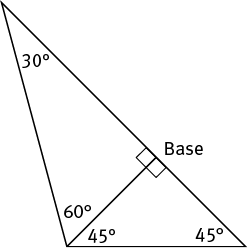
For the 45-45-90 triangle, the ratio of corresponding sides is x:x:x
 . Since the side across from the 90-degree angle is
. Since the side across from the 90-degree angle is
 , the other two sides must equal 2. That means that the height of the triangle is
2. This also means that the lower part of the base is equal to 2.
, the other two sides must equal 2. That means that the height of the triangle is
2. This also means that the lower part of the base is equal to 2.
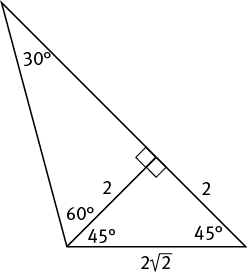
For the 30-60-90 triangle, the ratio of corresponding sides is x:x
 :2x. The side opposite the 30-degree angle is equal to 2, so x = 2. This means that the side opposite the 60-degree angle is 2
:2x. The side opposite the 30-degree angle is equal to 2, so x = 2. This means that the side opposite the 60-degree angle is 2
 . Therefore, the final length of the base of this triangle is 2 + 2
. Therefore, the final length of the base of this triangle is 2 + 2
 .
.
Remember, the question asked for the area of this triangle. You now have all of the components needed to calculate this value. The area of a triangle is
 (base)(height). So you have
(base)(height). So you have
(A) is correct.
Step 4: Confirm Your Answer
Reread the question stem, making sure that you didn’t miss anything about the problem.
- (C)
Step 1: Analyze the Question
There are a number of observations you can make from the figure before you review the Roman numeral statements and answer choices. This step will save valuable time when evaluating the answer choices.
First, notice that two of the angles are the same, x. This means that their corresponding opposite side lengths are equal. Angle A is opposite side BC, which equals 10, so side AB also equals 10.
Next, note that all three angles within the triangle are defined in terms of one variable, x. You know that the sum of the angles within the triangle must equal 180, so if needed, you can calculate the exact value of each angle. You do not need to complete the calculation now, but it is useful to know you can do so if needed.
Finally, look at the relationship among the three angles in the triangle. Two angles are equal to x, and the third is defined as x − 15. This means that the third angle is smaller than the other two and, therefore, its corresponding opposite side is also smaller than the other two sides, or less than 10.
Step 2: State the Task
Evaluate each Roman numeral statement looking for what must be true. Using the deductions you made in Step 1will help.
Step 3: Approach Strategically
Begin by evaluating Statement I because it appears most frequently in the answer choices.
Statement I: x > 50. One of the most efficient ways to determine this is to see what will happen if x = 50. This will tell you whether x needs to be larger or smaller.
If x = 50, the sum of the angles within the triangle will be 50 + 50 + (50 – 15) = 100 + 35 = 135. You know that the sum of the angles must equal 180, so x must be larger than 50, and Statement I is true. Eliminate (B). Notice that you did not solve for the actual value of x, though you could have if needed. Remember that on Test Day, you should only work out the calculations that are absolutely necessary so that you manage your time efficiently.
Statements II and III each appear twice in the remaining choices, and the deductions you made earlier help equally with both.
Statement III: AB > 10. From your analysis in Step 1, you know this cannot be true, because AB actually equals 10. Eliminate (D) and (E).
Statement II: AC < 10. As with III, you know from your earlier analysis that this is indeed true, because the angle opposite side AC is smaller than the other two angles. Eliminate (A). The correct answer is (C).
Step 4: Confirm Your Answer
Keep careful track of which side corresponds to which angle. Confirm that your answer makes sense logically based on the analysis done in Step 1.
- (B)
Step 1: Analyze the Question
A 2-inch frame is placed around a rectangular picture that measures 8 inches by 12 inches. The problem does not come with a figure, so be prepared to draw one.
Step 2: State the Task
Find the area of the frame, in square inches.
Step 3: Approach Strategically
Begin by drawing a figure:
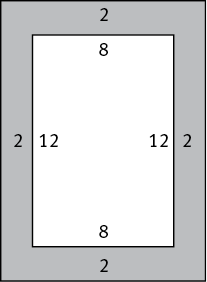
To find the area of the frame (the shaded area), you’ll need to find the total area—picture and frame together—and then subtract the area of the picture.
Including the 2-inch frame, the figure has dimensions of 12 by 16, for an area of 12 × 16 = 192. The picture itself has an area of 8 × 12 = 96. That means the frame alone has an area of 192 − 96 = 96. (B) is correct.
Step 4: Confirm Your Answer
Double-check the figure to ensure that it accurately reflects the information in the question stem.
- (B)
Step 1: Analyze the Question
You're told the area of the square garden, from which you can determine the length of each side of the square. You're also given the length that was added to the two sides of the square garden to form the larger rectangular garden. From this, you can determine the side lengths of the rectangle.
Step 2: State the Task
Find the perimeter of the added section of the garden; this is the sum of the lengths of its sides.
Step 3: Approach Strategically
The area of a square is the side length squared, so the side length can be found by finding the square root of the area. In this case, the side length is
 . Therefore, the width of the large rectangle is 6 + 4 = 10 meters, and the length is 6 + 10 = 16 meters.
. Therefore, the width of the large rectangle is 6 + 4 = 10 meters, and the length is 6 + 10 = 16 meters. At this point, you might be tempted to begin calculating the individual segment lengths that form the perimeter of the added section of the garden. However, since the "indented" section formed by the square has side lengths that are the two inner sides of the square, and because the outer two sides of the square sum to exactly the same length as the inner two sides, you can actually ignore this indent and just calculate the perimeter of the large rectangle. The perimeter of a rectangle is (2 × length) + (2 × width); here, that's (2 × 16) + (2 × 10) = 32 + 20 = 52 meters. Therefore, the perimeter of the added section of garden is 52 meters. (B) is correct.
Step 4: Confirm Your Answer
Make sure you found the perimeter of the added portion of the garden. If you found its area, you chose (D). Furthermore, double-check that you accounted for the length of each side exactly once.
- (B)
Step 1: Analyze the Question Stem
This Yes/No question requires that you determine whether there is enough information to answer the question “Is the length of a side of square S greater than the length of a side of the equilateral triangle T?” Let a be the length of a side of square S and let b be the length of a side of equilateral triangle T. Then you can paraphrase the question as “Is a > b?” There is no information in the question stem that you can use to determine whether or not there is sufficiency, so look at the statements.
Step 2: Evaluate the Statements Using 12TEN
Statement (1) says that a + b = 22. Here, a could be greater, b could be greater, or a and b could be equal. If a = 18 and b = 4 (they have to be consistent with Statement (1), so they must total 22), then a > b, and the answer to the question is yes. However, if a = 4 and b = 18 (again, consistent with Statement (1), as they total 22), then a < b, and the answer to the question is no.
Because different answers to the question are possible, Statement (1) is insufficient. Eliminate (A) and (D).
Statement (2): The ratio of the perimeter of the square to the perimeter of the triangle is 5 to 6. The perimeter of the square is 4a. The perimeter of the equilateral triangle is 3b. Thus, you can write the equation
 . Since this equation gives a proportional relationship between a and b, you know that you could simplify this equation and answer the question with a definite yes or no. Because a and b are side lengths, a and b are both positive, so this equation will describe a consistent ratio between these
values. Note that you don’t have to solve for the ratio in order to know that
Statement (2) is sufficient. (B) is correct.
. Since this equation gives a proportional relationship between a and b, you know that you could simplify this equation and answer the question with a definite yes or no. Because a and b are side lengths, a and b are both positive, so this equation will describe a consistent ratio between these
values. Note that you don’t have to solve for the ratio in order to know that
Statement (2) is sufficient. (B) is correct.
- (A)
Step 1: Analyze the Question
A given circle has an area of 16π.
Step 2: State the Task
Find the length of an arc formed by a 45° central angle. Even though arc length is related to circumference, not to area (the measurement given to you in the question stem), you can use the area to solve for the length of the radius and the radius to solve for the circumference.
Step 3: Approach Strategically
This problem seems complicated at first, but it is quite manageable if you take things step-by-step.
The area of a circle is πr2, so a circle with an area of 16π has a radius of 4. The circumference of a circle is 2πr, so the circumference of this circle is 8π. To find the length of the arc, set up a proportion that relates it to the central angle:

(A) is correct.
Step 4: Confirm Your Answer
When setting up a proportion, ensure that the correct items are placed in the correct positions.
- (D)
Step 1: Analyze the Question
This is a classic GMAT geometry question. The figure contains one circle inside a larger circle. There are three components for any such question: (1) the area or perimeter of the inner shape, (2) the area or perimeter of the outer shape, and (3) the area or perimeter of the combined shape. Remember that oddly shaped figures are composed of combinations of simpler ones. In this case, the shaded region is the difference in area between the two circles.
Step 2: State the Task
Calculate the area of the walkway, or outer shape in the figure. The area of the walkway is equal to the area of the large circular region minus the area of the circular garden, so you must calculate these two values separately and then take their difference.
Step 3: Approach Strategically
First, find the area of the inner circle. The formula for the area of a circle is πr2. From the figure, you know that r = 9, so the area of the inner circle is
πr2 = π(9)2 = 81π
Now solve for the area of the combined (larger) circle. The radius of the combined circle is the sum of the radius of the garden plus the width of the walkway. So the radius is 9 + 4 = 13, and the area of the large circular region is
πr2 = π(13)2 = 169π
Now you can solve for the area of the walkway. This value is the difference of the two values you calculated above: 169π – 81π = 88π. The correct answer is (D).
Step 4: Confirm Your Answer
Confirm that your answer makes sense in the context of the question. Notice that you can eliminate (E) using logic, because the walkway must be smaller in area than the total combined area of the two circles. This step would also save you a wrong answer if you accidentally selected the area of the garden, (C).
- (D)
Step 1: Analyze the Question Stem
This is a Value question. For any circle question, you only need one defining parameter of a circle (area, circumference, diameter, or radius) in order to calculate any of the other parameters. Also, all radii of the same circle will have the same length. So AO = CO. That makes the triangle an isosceles right triangle (or 45-45-90) for which you know the ratio of the side lengths. Not only would the circle’s area, circumference, diameter, or radius be sufficient, but information that gave you any side length of triangle AOC would also be sufficient, as it would give you the length of the radius.
Step 2: Evaluate the Statements Using 12TEN
Statement (1) gives you the area of the triangle, and you already know that the base and the height are equal. So if you call the radius of the circle r, then the area of the triangle is equal to

Remember that you are not asked to calculate the actual value of r. Because you have set up an equation with one variable, and you know in this case that r can only be positive since it is part of a geometry figure, you have enough information to determine the area of the circle (the solution would have been r2 = 36, so r = 6).
Therefore, Statement (1) is sufficient. You can eliminate (B), (C), and (E).
Statement (2): Because O is the center of the circle and angle AOC measures 90 degrees, you know that the length of arc ABC is one-fourth of the circumference. Because this statement allows you to solve for the circumference, it is sufficient.
The correct answer is (D).
- (A)
Step 1: Analyze the Question
This question presents you with a complex figure consisting of three triangles inscribed in a semicircle. You are told that PQ is parallel to OS.
Step 2: State the Task
Find the measure of ∠ROS.
Step 3: Approach Strategically
The problem looks downright daunting, but the key, as with all geometry problems that involve complex figures, is to use any concrete information given to determine the starting point. With that in mind, begin by listing what you know from the figure:
- Two of the three sides of each of the three inscribed triangles are radii of the semicircle. That means the three inscribed triangles are isosceles.
- Since PQ is parallel to OS, QO is a transversal. When a transversal intersects with a pair of parallel lines, alternate interior angles are equal. In this case, since ∠PQO = 70°, ∠QOS must also be 70°.
Add this information to your sketch of ∆QOR and ∆ROS:
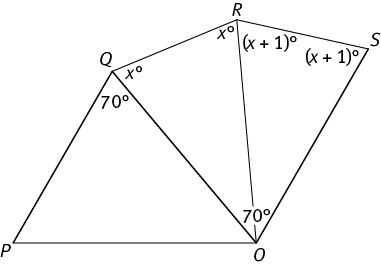
As you can’t simply split angle ∠QOS in half to find your answer (you can’t make assumptions about the relative sizes of angles just from eyeballing the diagram), you’ll instead need to solve for x. To do so, recall that a triangle’s interior angles sum to 180°. If you add up all six interior angles from ∆QOR and ∆ROS, you’ll have a sum of 360°. You can now set up an equation to solve for the value of x.

Since x = 72, each of the two base angles in ∆ROS is 72 + 1 = 73°. Therefore, the measure of ∠ROS is 180 − 2(73) = 180 − 146 = 34°. The correct answer is (A).
Step 4: Confirm Your Answer
If you were pressed for time, a bit of Critical Thinking would reveal that isosceles triangles with base angles of approximately 70° cannot possibly allow a remaining angle as large as (C), (D), or (E) would indicate.
- (A)
Step 1: Analyze the Question Stem
For this Value question, you can make the following observations from the figure:
In triangle DFC, the measure of angle DFC is 180° − 70° − 60° = 50°.
Angle BFG is vertical to angle DFC, so the measure of angle BFG is also 50°.
In triangle FBG, the measure of angle GBF is 180° − 50° − 60° = 70°.
Angle ABF completes a straight line with angle GBF, so the measure of angle ABF is 180° − 70° = 110°.
Angles GFC and BFD each complete a straight line with angle DFC, so the measure of each of these angles is 180° − 50° = 130°.
There are many things that would give you the value of x. You have two of the angles in quadrilateral ABFD, so getting the measure of angle FDA would give you the third and allow you to solve for x (all quadrilaterals have interior angles that sum to 360°). It’s a complex figure, so there may be other ways to solve for x as well. You’ll need to think carefully about any information you’re given.
Step 2: Evaluate the Statements Using 12TEN
Statement (1) states that AD is parallel to BC. Therefore, angle GBF and the angle marked x° must be equal. Because the measure of angle GBF is 70°, the measure of the angle marked x° must be 70°. Thus, x = 70. Statement (1) is sufficient. You can eliminate (B), (C), and (E).
Statement (2) tells you that ∠GBC = 70°. You already concluded that ∠GBF = 70° when you gathered information from the figure in Step 1. Because angle GBF is the same as angle GBC, this statement does not provide you with any new information and is therefore insufficient.
The correct answer is (A).
- (D)
Step 1: Analyze the Question
"An isosceles triangle is inscribed in a circle" means that each vertex of a triangle with at least 2 sides of equal length is on the circumference of a circle. Furthermore, "one of the triangle's sides coincides with the circle's longest chord" means that one side of the triangle is a diameter of the circle. When a side of a triangle that's inscribed in a circle is a diameter of the circle, the vertex across from the diameter is a right angle, so the triangle is a right triangle and the side that coincides with the diameter is its hypotenuse. You're also told that the measure of another side of this triangle is 5. Since the triangle is isosceles, the third side must also have a length of 5, and the angles that are opposite those sides must also be of equal measure. Since one angle already measures 90°, each of the other two measures 45°. Thus, the inscribed figure is a 45°-45°-90° triangle.
Sketching a figure on your noteboard to visualize the figures will be helpful. Your sketch might look something like this:
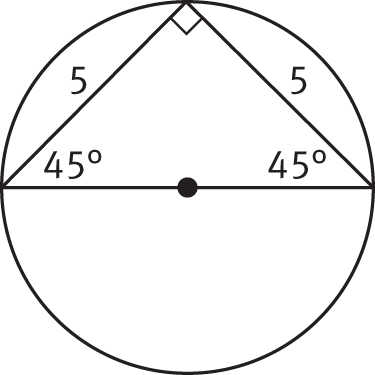
Step 2: State the Task
Determine the difference between the circle's area and the triangle's area, or AC − AT.
Step 3: Approach Strategically
You're given a measure of one of the triangle's sides, so start by finding the area of the triangle. Since it is a right triangle, one leg is the triangle's base, and the other leg is the height. Substitute those lengths into the formula for area of a triangle:
 .
.The formula for area of a circle is πr2, so to find the area of the circle, you need to know the radius. In this figure, the radius of the circle is half the length of the triangle's hypotenuse. Because the triangle is a 45°-45°-90° triangle, the measures of the sides are in the ratio
 . Thus, since each of the two legs measures 5, the hypotenuse measures
. Thus, since each of the two legs measures 5, the hypotenuse measures  . This is also the circle's diameter, so the radius is half of
. This is also the circle's diameter, so the radius is half of  , or
, or  . Thus, the circle's area is this:
. Thus, the circle's area is this:
Finally, the area of the circle minus the area of the triangle is
 , which matches (D)—the correct choice.
, which matches (D)—the correct choice.On Test Day, if you were behind on time and needed to make a strategic guess, you could note that (A) stands out as being the only choice whose binomial factor doesn't begin with π. Indeed, because π is greater than 1, 1 − π is negative. This choice is thus the product of a positive number and a negative number, which is negative. The difference between the area of a circle the area of a triangle inscribed within it must be positive, so you could eliminate (A) and guess from among the other choices.
Step 4: Confirm Your Answer
Ensure that you answered the question, which asks for the difference in areas between the circle and the triangle. Potential trap answers include (A), which is the area of the triangle minus the area of the circle, and (C), which is the sum of the two areas.
- (B)
Step 1: Analyze the Question
There are two cylindrical tanks. The first is completely full of gasoline, which is all transferred to the second. The height of the first tank is given. Both the height and the diameter of the second tank are given, but that height is actually irrelevant since you're not finding the volume of the second tank; what is relevant is the height that the gasoline reaches in that second tank. The key to such a transference problem is noting that the volume of the gasoline in the original tank must equal the volume of the gasoline in the new tank.
Step 2: State the Task
Use the formula for volume of a cylinder to find the diameter of the original tank.
Step 3: Approach Strategically
The volume of any uniform solid is equal to the area of its base times that solid's height, so the volume of a right circular cylinder is πr2h. More information is given about the second cylinder, so start there. It has a diameter of 24 feet, so its radius must be 12 feet. The gasoline fills it to a height of 2 feet, so use 2 for the height. Thus, the volume of the gasoline in that tank is π(12)2(2) = 288π ft3.
Now, plug this value back into the volume formula for the first cylinder to find its diameter: 288π = πr2(8), so r2 = 36 and r = 6 ft. The answer is (B).
Step 4: Confirm Your Answer
As always, be sure to read the question stem carefully, noting the key details. Here, the diameter, not the radius, of the second tank's base was given and the gasoline did not reach the top of the second tank.
- (D)
Step 1: Analyze the Question
The question stem tells you that the number of units in a rectangular solid's volume and the number of units in that solid's surface area are the same. Recall that the volume of a rectangular solid is Length × Height × Width and that the surface area is the sum of the areas of all 6 faces. You are also given specific values (4 and 5) for two of the three dimensions of the solid.
Step 2: State the Task
Determine the sum of the areas of the two largest faces of the solid.
Step 3: Approach Strategically
The solid's volume and surface area are equal values, so
 . Since you are not told which dimensions 4 and 5 represent, simply substitute those values into this equation in a consistent way, assigning x to the third dimension. If, say,
. Since you are not told which dimensions 4 and 5 represent, simply substitute those values into this equation in a consistent way, assigning x to the third dimension. If, say,  and w = 5, then 4(5)x = 2(4)(5) + 2(4)x + 2(5)x. Now, solve for x:
and w = 5, then 4(5)x = 2(4)(5) + 2(4)x + 2(5)x. Now, solve for x:
Because 20 is greater than 4 or 5, 20 is the largest dimension of the solid. Use that value and the second-largest dimension's measure to find the area of each of the largest faces of the solid: 20(5) = 100. Finally, since opposite faces of a rectangular solid have the same area, double 100 to determine the sum of the areas of those two largest faces: 2(100) = 200.
The correct choice is (D).
Step 4: Confirm Your Answer
Ensure that you answered the question asked. For example, if you stopped working after solving for x, you might have selected (A). If you forgot to double the area in the last step, (C) was waiting for you.
- (C)
Step 1: Analyze the Question
The question stem tells you that a cube with edge 6 contains the largest possible sphere that completely fits inside of it. So the length of the sphere's diameter is the same as the length of the cube's side. There is also some empty space in the cube that is not occupied by the sphere; this is the three-dimensional equivalent of inscribing a circle in a square—there's some empty space in the corners. The formula for the volume of a sphere is given to you. Recall that the volume of a cube is the edge length cubed.
Step 2: State the Task
Determine the volume of the empty space in the cube, which is the difference between the cube's and sphere's volumes:
 .
. Step 3: Approach Strategically
You're given concrete information about the cube, so start by finding its volume:
 .
.Now use the given formula to find the volume of the sphere. Since the length of the sphere's diameter is the same as the length of the cube's edge, the sphere's radius is half the length of the cube's edge:
 . Plug this in for r in the formula:
. Plug this in for r in the formula:  .
.Now, determine the volume of the empty space in the cube:
 . This doesn't look like any of the answer choices, which all begin with a factor of 36. Factor 36 out of this expression to get 36(6 − π).
. This doesn't look like any of the answer choices, which all begin with a factor of 36. Factor 36 out of this expression to get 36(6 − π).This matches (C), which is the correct choice.
Step 4: Confirm Your Answer
Make sure you determined the difference between the volume of the cube and the volume of the sphere and not some other value, starting with confirming that you correctly derived the sphere's radius.
- (C)
Step 1: Analyze the Question Stem
This is a Yes/No question asking whether two lines, each of which is represented by a unique equation, are parallel. Since two lines are parallel if they have the same slope, the statements are sufficient if they provide enough information to determine whether m and n, the slopes of lines
 and
and
 , respectively, are equal.
, respectively, are equal.Step 2: Evaluate the Statements Using 12TEN
Statement (1) says that m2 − n2 = 0. This is one of the "classic" quadratics; it factors to (m + n)(m − n) = 0. This means that m = n or −n. In other words, m and n have the same magnitude, but they could have either the same sign or opposite signs. So, if they had the same sign, the slopes would be equal and the answer to the question would be yes, but if they had opposite signs, the slopes would not be equal and the answer would be no. Thus, this statement is insufficient; eliminate (A) and (D).
Statement (2) says that the product of m and n is positive. This means that m and n have the same sign; they're either both positive or both negative. Without more information, though, there's no way to know whether they're equal, so this statement is insufficient. Eliminate (B).
Now, combine the statements. According to (1), m = n or −n, but according to (2), m and n must have the same sign. That leaves m = n as the only possibility. Even though there's not enough information to determine what the slopes are, they must be equal to each other. Choose (C).
- (C)
Step 1: Analyze the Question
You're given the x- and y-coordinates of one of the three vertices of triangle ABC, the x-coordinates of the remaining two vertices, and the area of the triangle. Since the y-coordinates of the two vertices not specified are both represented by y, they are the same, so the side BC of the triangle is parallel to the x-axis. Additionally, side AB lies on the y-axis, so this is a right triangle.
Step 2: State the Task
Determine the y-coordinate of points B and C on the graph.
Step 3: Approach Strategically
Since you are given the area of the triangle, use the formula for the area of a triangle to determine the missing coordinate:
The area of triangle ABC =
 . Since the graph indicates that the base of the triangle extends from point (0,y) to point (9,y), the base has a length of 9, so
. Since the graph indicates that the base of the triangle extends from point (0,y) to point (9,y), the base has a length of 9, so  . Simplifying yields 9 × height = 54, so height = 54 ÷ 9 = 6. Since vertex A lies at point (0,9), the y-coordinate of vertex B must be 9 − 6 = 3. Thus, y = 3. The correct choice is (C).
. Simplifying yields 9 × height = 54, so height = 54 ÷ 9 = 6. Since vertex A lies at point (0,9), the y-coordinate of vertex B must be 9 − 6 = 3. Thus, y = 3. The correct choice is (C).Step 4: Confirm Your Answer
Use the height you've calculated from the y-coordinate you've found to check whether the area matches that in the question stem. Note also that 6 in (E) is a trap answer for the unwary test taker, since that's the height of the triangle, not the value of y.
- (B)
Step 1: Analyze the Question
For any question involving the equation of a line, a good place to start is the slope-intercept form of the line, y = mx + b. Remember that if you have two points on a line, you can derive the entire equation, and if you have an equation of the line, you can calculate any points on that line.
Step 2: State the Task
You must solve for k, which is the amount by which the y-coordinate increases when the x-coordinate increases by 2.
Step 3: Approach Strategically
The slope of a line is the ratio between the change in y and the change in x. In other words, every time the x-coordinate increases by 1, the y-coordinate increases by the amount of the slope.
The equation of the line in the question stem is defined as x = 2y + 5. You must isolate y to have slope-intercept form:

So the slope of this line is
 . This means that for every change of +1 in the x direction, there is a change of +
. This means that for every change of +1 in the x direction, there is a change of + in the y direction. Therefore, you know that, because there is an increase of 2 units in the
x direction when moving from m to m + 2, there must be a change of 1 unit in the y direction when moving from n to n + k. So k = 1.
in the y direction. Therefore, you know that, because there is an increase of 2 units in the
x direction when moving from m to m + 2, there must be a change of 1 unit in the y direction when moving from n to n + k. So k = 1.
Since there are variables that eventually cancel (m and n are not part of the answer choices), you can use picking numbers. Say that you choose the y-coordinate of the point (m, n) to be 0 to allow for easier calculations. Using the equation you’re given to relate x- and y-coordinates, you can calculate the x-coordinate:

So (m,n) is the point (5,0).
Now you’ll plug your values of m and n into the next point: (m + 2, n + k). That yields (7,k). All you have to do is plug an x-coordinate of 7 into the equation to solve for k, the y-coordinate:

(B) is correct.
Step 4: Confirm Your Answer
Reread the question, making sure that you didn’t miss anything. For example, if you thought that the original equation was y = 2x + 5, then you would have answered (E). This step would help you to catch that error.